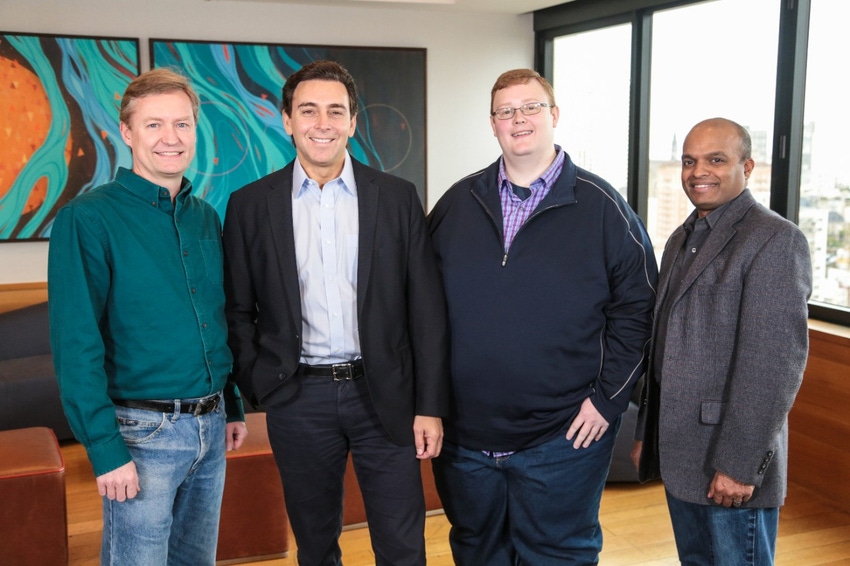Here’s Why We Keep Hearing About Autonomous Car Partnerships
Op Ed: Automakers weren’t always so public about their alliances. Now that’s changing.
August 2, 2017

Lately, it’s almost impossible to flip through the business pages of a newspaper without reading about an autonomous car partnership -- General Motors, Ford, BMW, or Toyota, teaming with up-and-coming tech companies with names like Nauto Inc., Mobileye N.V., SAIPS, Argo AI, Cruise Automation, or Civil Maps.
The investment dollar figures are often staggering. A few weeks ago, for example, two-year-old startup Nauto Inc. closed a $159 million round of funding that involved GM, BMW and Toyota. Similarly, last year, GM plunked down $581 million for tiny Cruise Automation. And in February, Ford invested $1 billion in the robotics company, Argo AI.
|
In February, Ford invested $1 billion in the robotics company, Argo AI, which was founded by former Google and Uber leaders. (Source: Ford Motor Co.) |
Part of the reason, of course, is the rapid development of autonomous car technology. During the past decade, self-driving vehicles have evolved from technical curiosities at the DARPA Challenge to corporate necessities.
“The OEMs are targeting 2020 to 2023 for higher levels of autonomy,” Nauto spokeswoman Jeanne Meyer told Design News. “So there’s a pressure and a need to get the technology moving. And if it means investing in start-ups that are dedicated to that, that’s one option.”
There is, however, one other reason we keep hearing about these partnerships. And to understand that reason, one needs look no further than the stock valuation of Tesla. It’s said that a share of Tesla’s stock now is now valued at about $500,000 for each car it sells, whereas GM’s is about $5,000 per car sold.
Public perception is key. The auto companies, the Tier One and Tier Two suppliers, the start-ups – all of them want to be perceived in the same light as Tesla. Or Apple. Or Waymo (previously known as the Google self-driving car project). They want to be recognized as high-tech, cutting edge.
Most auto journalists recall a time, not long ago, when automakers didn’t discuss partnerships. Questions in that vein were politely deflected. “OEMs were always loathe to talk about who their suppliers were, or who they were working with,” Sam Abuelsamid, senior analyst for Navigant Research, told us recently. “That’s what’s new here. It’s the PR factor.”
Indeed, the public relations factor is huge, and Detroit needs all the help it can get in that regard. Much of the country considers Tesla, Waymo, and Apple superior to the old line automakers when it comes to building autonomous cars. In the public’s mind, those are high-tech companies, whereas the automakers are metal benders. “Public perception is that the Silicon Valley is way ahead on developing this technology,” Abuelsamid said. “More important than that, though, is that the public trusts the Silicon Valley to do it right.”
Still, Navigant’s recent Autonomous Driving Systems Leaderboard didn’t place Waymo, Apple, or Tesla in the top spots when it came to self-driving technology. Rather, Ford finished at the top, followed by GM and Renault-Nissan. When manufacturing, business and technology were all taken into consideration, Waymo ranked seventh. Tesla was twelfth. �
That’s why the old line auto industry has developed a kind of collective twitch when it comes to public relations. They know they’re deep in the game, but they’re afraid you don’t. So they want you to see the partnerships, investments and acquisitions. They want you to know, we’re not behind. It’s why so many of the Tier One auto suppliers are now showing up at the Consumer Electronics Show in Las Vegas in January. It’s their way of informing the electronics media, the technological cognoscenti, hey, we’re relevant.
Clearly, it’s a case of perception versus reality. And perception is winning.
The irony is that the Silicon Valley still has a lot to learn about autos. Yes, they understand robotics, semiconductors, and software, but the auto industry is more than that. It’s about safety, reliability, and service. The stakes are different. Kludgy phones generally don’t kill their owners.
Still, Wall Street’s scoreboard tells a different story. So automakers want us all to understand … they’re high-tech, too. “They don’t want to be seen as being behind,” Abuelsamid said. “But in reality, they’re not behind.”
 Learn more about autonomous and connected cars at the Embedded Systems Conference (ESC) in Minnesota. Over two days, Nov. 8-9, 2017, receive in-depth education geared to drive a year’s worth of work. Uncover software design innovation, hardware breakthroughs, fresh IoT trends, product demos, and more that will change how you spend time and money on your next project. Register today!
Learn more about autonomous and connected cars at the Embedded Systems Conference (ESC) in Minnesota. Over two days, Nov. 8-9, 2017, receive in-depth education geared to drive a year’s worth of work. Uncover software design innovation, hardware breakthroughs, fresh IoT trends, product demos, and more that will change how you spend time and money on your next project. Register today!
About the Author(s)
You May Also Like




